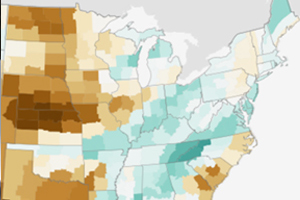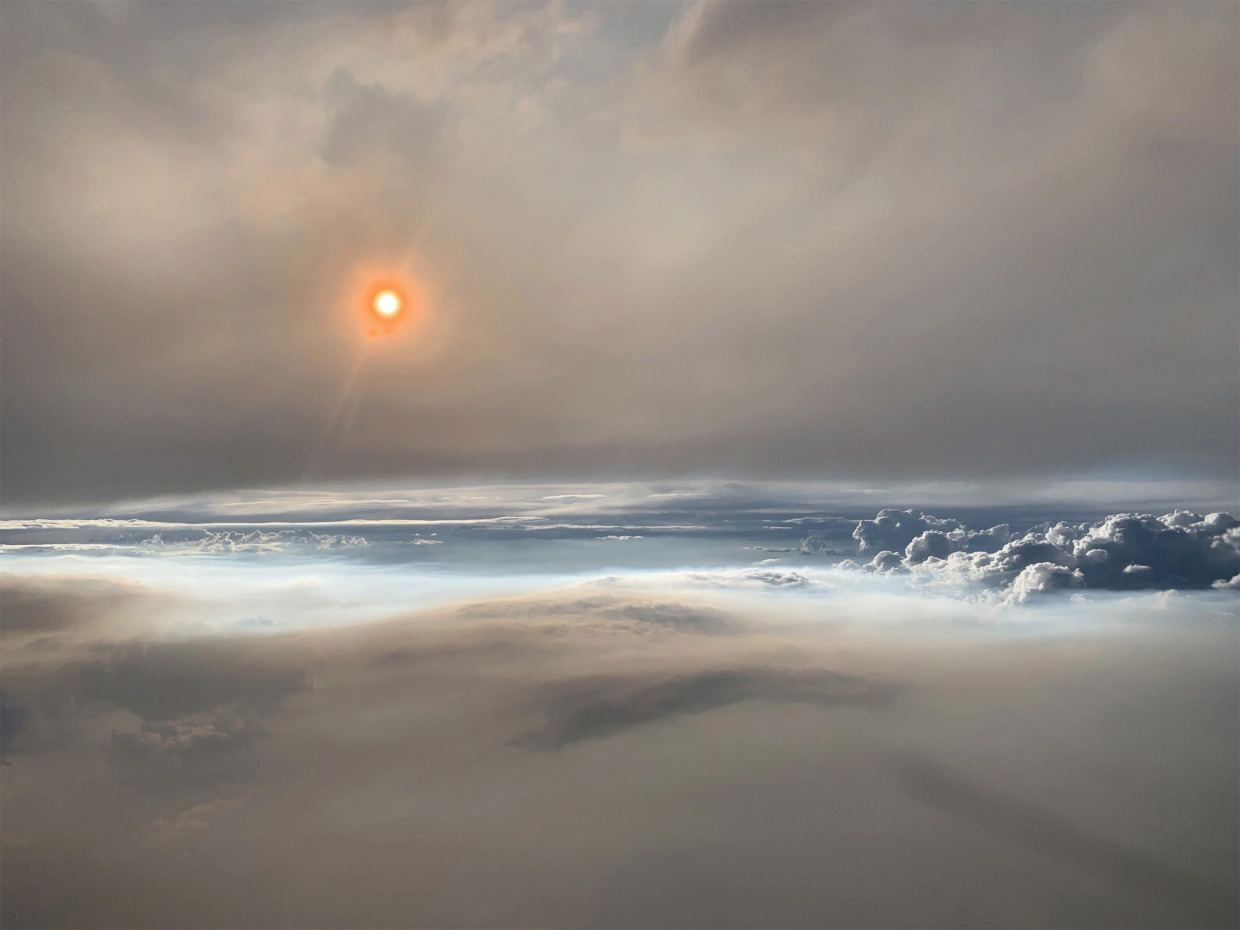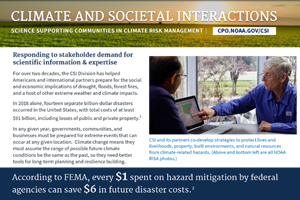These social media channels regularly promote CPO science and events, as well as Climate.gov publications.
Communication
Through social media, the Climate Program Office website, strategic communications initiatives, Climate.gov, and its partnerships, the Communication Program reaches a variety of target audiences with tailored information. Strategic communications focus on internal NOAA audiences, Congress, the White House, and the scientific community. Climate.gov focuses on building climate literacy in the science-interested public. From time to time, Climate.gov also explains and promotes awareness of CPO-funded research.
All Communication Program work promotes awareness of current climate conditions, their causes, and their impacts. Extensive partnerships allow the program to expand its capacity and disseminate its information more broadly.


Americans are increasingly seeking scientific information from NOAA to understand the mechanisms and causes of climate change and its impact on their lives. Climate.gov is CEE’s flagship publication for building climate literacy with authoritative scientific data and information. It is three audience-focused websites in one.

News & Features
News & Features is a magazine for the science-interested public covering major topics in climate science, adaptation, and mitigation.


Maps & Data
At Climate.gov’s Maps & Data section, the Data Snapshots tool offers a menu of easy-to-interpret maps that anyone can download and use in their own communication efforts.


Global Climate Dashboard
Users can display data trends from a variety of climate indicators in the Global Climate Dashboard.


El Niño & La Niña
The El Niño & La Niña section gives the latest status and forecasts of ENSO conditions in the equatorial Pacific Ocean.
Teaching Climate
Climate.gov’s Teaching Climate section offers reviewed learning activities and curriculum materials, multimedia resources, and professional development opportunities for formal and informal educators who want to incorporate climate into their work. The educational resources are curated by the Climate Literacy and Energy Awareness Network (CLEAN), launched in November 2010 as a new National Science Digital Library (NSDL) Pathways project. The CLEAN collection of climate and energy educational resources contains more than seven hundred digital learning resources that are free, ready-to-use, and rigorously reviewed by educators and scientists for quality assurance. The lessons are suitable for primary through higher education.
Social Media
The Communication, Education, and Engagement division runs the “NOAAClimate” social media handles on Facebook (@NOAAClimategov), Twitter (@NOAAClimate), Instagram (NoaaClimate), and YouTube (https://www.youtube.com/user/NOAAClimate). Reaching over 350,000 users daily, our social media is one of the largest climate outreach and engagement efforts across the federal government. At least twice a day, our accounts promote the latest climate news, research, literacy, and solutions to our science-engaged audience.
Through social media, we routinely engage with core audiences including the media, decision makers, scientists, NGOs, informal and formal educators, and the science-interested public. Through these channels, we also host engagement events such as Twitter Chats. At Twitter Chats, climate scientists, educators, and/or decision makers converse with our followers on topics like urban heat, sea level rise, climate education, wildfires, clouds, climate monitoring, and large international scientific field campaigns. In 2019, Climate.gov hosted a chat with experts about a NASA/NOAA field campaign to study smoke from wildfires and agricultural burning.


Climate Program Office website
The Communication, Education, and Engagement Division and other divisions and programs in the Climate Program Office contribute to and update the CPO website. The website primarily speaks to the White House, Congress, NOAA leadership and communications, and the climate science community.
At the CPO website, the CEE team regularly publishes web stories announcing scientific advances funded by CPO and profiling scientists funded by CPO. Every fall, the CEE team organizes the CPO funding award announcement, allocating millions of dollars to advance climate and decision support science, and build community resilience. The Communication, Education, and Engagement Division and other divisions and programs in the Climate Program Office contribute to and update the CPO website. The website primarily speaks to the White House, Congress, NOAA leadership and communications, and the climate science community.
CPO Strategic Communications


Weekly Updates to NOAA Leadership on Successes
To keep NOAA leadership informed of CPO science news, CPO speaking engagements, science publications, and other important developments, the CEE Division organizes a weekly “Hot Items” report. A Hot Item is a short written notice--typically no longer than two paragraphs. It uses plain language to communicate only the most significant information.


Briefing Materials
For communications to the White House, Congress, NOAA leadership, and peer organizations, the CEE Division maintains a library of briefing sheets describing the societal and economic impacts of CPO divisions and programs, observed climate impacts and projections on a nationwide and state-by-state basis, and the success stories of CPO as a whole. Contact CEE staff for more information.


Controlled Correspondence/Questions for the Record
Official requests for information on CPO-related matters from the White House, Congress, NOAA leadership, and the Department of Commerce may require response from the CEE Division.
Partnerships
The Communication Program of the CEE Division gains strength from its many partnerships. The program works closely with the National Environmental Modeling and Analysis Center (NEMAC) at UNC-Asheville on the development and maintenance of the U.S. Climate Resilience Toolkit and its featured Climate Explorer tool. NEMAC specializes in science communication, data visualization, interface designs, and tool development.
We also work closely with NOAA’s Environmental Visualization Laboratory (EVL) on the development of data visualizations and maps for use by Climate.gov, the Climate Resilience Toolkit, and other publications. The EVL specializes in using cutting-edge technologies and best practices in producing satellite imagery and data visualizations in support of NOAA’s wide-ranging communication, education, and engagement objectives.
In addition, about 5 years ago, the CEE Division entered into a partnership with the Association of Climate Change Officers (ACCO), a nonprofit professional development organization for people addressing climate change in their organizations’ operations and mission. CEE personnel assisted ACCO in the development of several climate science courses in its curriculum and have been regularly teaching ACCO courses for participants across the nation and internationally.
We also enjoy a partnership with CAPA Strategies, LLC. CAPA’s flagship service, Heat Watch, provides high-resolution descriptions of urban heat across the ambient environment through a coordinated data-collection campaign with local communities and organizations. CEE supports citizen scientists taking to their streets during the hottest days of summer to map hot spots in cities across the nation. The campaign is part of a NOAA-funded project to map places where buildings, asphalt, and other parts of urban environments can amplify high temperatures, putting people at heightened risk of heat illness during extreme heat events. Over the past three years, NOAA has funded CAPA Heat Watch to support 21 communities across the United States in mapping their urban heat islands (UHI).


